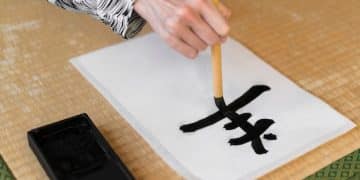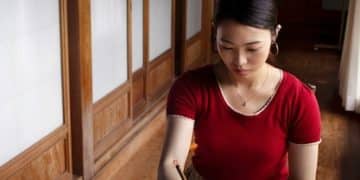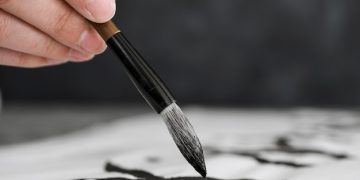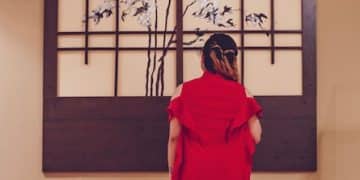Korean Calligraphy for US Enthusiasts: Styles & Techniques
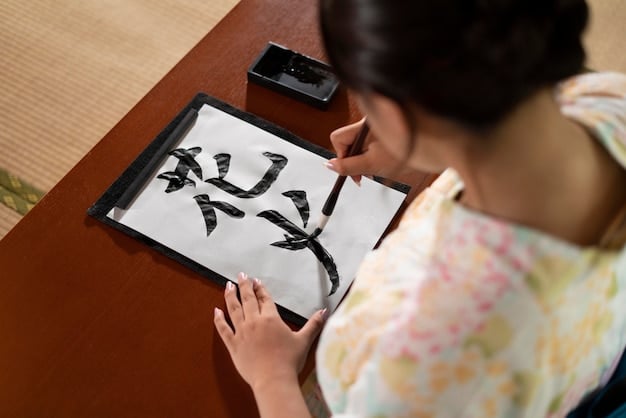
Exploring the World of Korean Calligraphy: Techniques and Styles for US Enthusiasts reveals the historical art form, its distinct styles like Hangeul and Hanja, essential techniques for beginners, and resources available in the US to nurture your calligraphy journey.
Dive into the captivating world of Korean calligraphy, a beautiful and expressive art form that blends history, culture, and artistic skill. Exploring the World of Korean Calligraphy: Techniques and Styles for US Enthusiasts offers a starting point for those in the US who are curious to learn more.
Unveiling the History and Significance of Korean Calligraphy
Korean calligraphy, known as Seoye (書藝), is more than just beautiful writing. It’s a respected art form with deep roots in Korean history and culture. Understanding its heritage is essential for appreciating its aesthetic and philosophical value.
Seoye reflects Confucian principles and embodies the artist’s spirit through ink and brush. It’s closely tied to other art forms like painting and poetry, often appearing alongside them to enhance their meaning.
The Origins of Seoye
The art of Korean calligraphy draws inspiration from Chinese calligraphy, introduced centuries ago. However, it evolved to incorporate unique Korean characteristics and artistic sensibilities.
The Importance of Seoye Today
Even in the digital age, Seoye remains a vital part of Korean culture. It is practiced by both professionals and amateurs, preserving a traditional art form while adapting to modern times. Cultural institutions actively promote calligraphy to ensure its continued relevance.
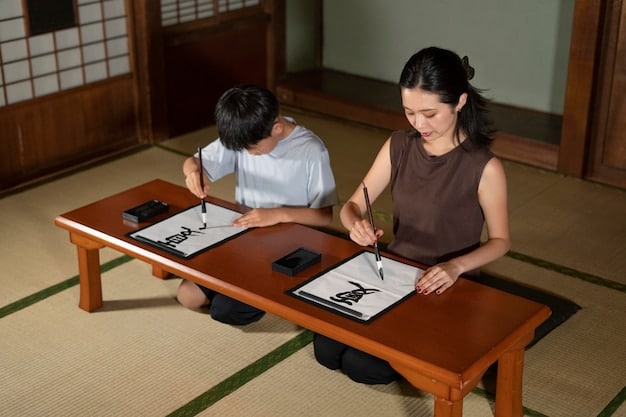
- Cultural Heritage: Korean calligraphy represents a significant aspect of Korean cultural identity, reflecting its history and values.
- Artistic Expression: Seoye allows artists to express their creativity and inner thoughts through dynamic brushstrokes.
- Spiritual Practice: Many view calligraphy as a meditative practice, fostering mindfulness and concentration.
- Interconnected Art: Seoye is linked to poetry and painting, offering a holistic appreciation of Korean arts.
Korean calligraphy continues to evolve, embracing new influences and interpretations while respecting its rich heritage. This blend of tradition and innovation keeps the art form alive and relevant for future generations.
Exploring Different Styles of Korean Calligraphy
Korean calligraphy isn’t a single style; it’s a diverse range of artistic expressions, each with its own techniques and characteristics. Learning about these styles can enrich your understanding and appreciation of Seoye.
The two main scripts used in Korean calligraphy are Hangeul, the Korean alphabet, and Hanja, Chinese characters adapted for Korean.
Hangeul Calligraphy
Hangeul calligraphy focuses on the aesthetic qualities of the Korean alphabet, showcasing its simplicity and elegance. It emphasizes the balance and harmony of vowels and consonants.
Hanja Calligraphy
Hanja calligraphy involves writing Chinese characters, which require a deep understanding of their meaning and stroke order. It reflects discipline and respect for traditional forms.
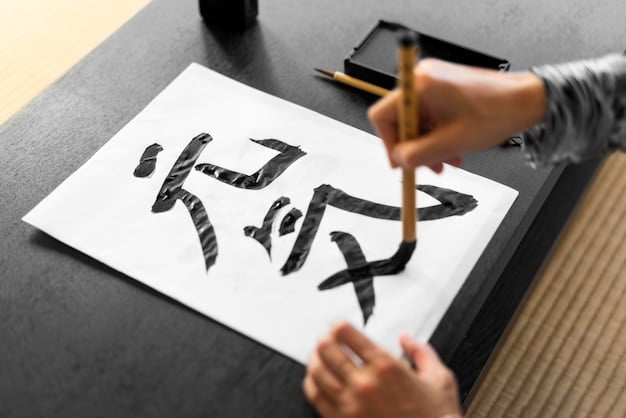
- Gongche: A formal and precise style of Hanja calligraphy, often used in official documents.
- Haeseo: A semi-cursive style of Hanja calligraphy, allowing for greater freedom of expression.
- Choseo: A cursive style of Hanja calligraphy, emphasizing fluidity and spontaneity.
- Minche: A modern style of Hangeul calligraphy that embraces contemporary design principles.
Understanding the different styles of Korean calligraphy can help you find the techniques and aesthetics that resonate with you. Each style offers a unique opportunity for creative exploration.
Essential Techniques and Materials for Beginners
Starting your journey in Korean calligraphy requires understanding the fundamental techniques and gathering the right materials. The good news is that many of these materials are accessible in the US.
Having the right tools and understanding basic brushstrokes will set a solid foundation for your calligraphy practice.
Gathering the Necessary Materials
You’ll need specific materials to begin practicing Korean calligraphy, including a calligraphy brush, ink stick and inkstone, Hanji paper, and felt mat.
Mastering Basic Brushstrokes
Korean calligraphy relies on a set of foundational brushstrokes, each requiring control and precision. Practicing these strokes is crucial for developing proficiency.
- Vertical Stroke: Start with downward pressure, gradually lifting the brush to create a tapering line.
- Horizontal Stroke: Move the brush smoothly from left to right, maintaining consistent pressure.
- Dot: Use a quick, deliberate motion to create a small, distinct dot.
- Hook: Add a subtle hook to the end of a stroke by flicking the brush upwards.
With practice and patience, you can master the essential techniques and begin exploring the expressive possibilities of Korean calligraphy.
Finding Resources and Learning Opportunities in the US
For US-based enthusiasts, there are numerous resources available to learn and practice Korean calligraphy. From online courses to local workshops, you can find the perfect option to suit your learning style.
Utilizing online platforms or local communities can provide valuable guidance and support as you develop your skills.
Online Courses and Tutorials
Many online platforms offer comprehensive courses in Korean calligraphy, taught by experienced instructors. These courses provide structured lessons and personalized feedback.
Local Workshops and Communities
Check for local workshops and calligraphy communities in your area. These offer hands-on learning experiences and opportunities to connect with fellow enthusiasts.
- Korean Cultural Centers: Many Korean cultural centers in the US offer calligraphy classes and workshops.
- Community Colleges: Some community colleges may offer introductory courses in Korean calligraphy.
- Art Organizations: Local art organizations often host workshops and events that feature Korean calligraphy.
- Online Forums: Join online forums and communities dedicated to Korean calligraphy to connect with other learners.
By tapping to the available resources, you can deepen your knowledge, refine your techniques, and become part of a supportive calligraphy community in the United States.
The Meditative and Therapeutic Benefits of Calligraphy
Beyond its artistic and cultural significance, Korean calligraphy offers numerous meditative and therapeutic benefits. Engaging in this practice can promote relaxation, improve focus, and enhance mental well-being.
The act of carefully forming each stroke cultivates mindfulness and fosters a sense of inner peace.
Mindfulness and Concentration
Calligraphy requires intense focus and concentration, helping practitioners to quiet their minds and be present in the moment. This mindful practice can reduce stress and improve overall cognitive function.
Creative Expression and Emotional Release
Calligraphy provides an outlet for creative expression and emotional release. Through the dynamic brushstrokes, artists can channel their emotions and transform them into visual art.
- Stress Reduction: Focusing on the rhythmic movements of calligraphy can alleviate stress and promote relaxation.
- Improved Focus: The concentration required for calligraphy tasks strengthens focus and attention span.
- Enhanced Creativity: Calligraphy allows for artistic expression and fosters creative thinking.
- Emotional Balance: The meditative aspect of calligraphy can promote emotional balance and self-awareness.
Integrating calligraphy into your routine can offer a holistic approach to wellness, nurturing both your artistic skills and your mental well-being.
Exhibiting Your Work and Joining the Calligraphy Community
As you progress in your calligraphy journey, consider exhibiting your work and connecting with the larger calligraphy community. Sharing your art and engaging with fellow artists can provide valuable feedback and inspiration.
Participating in exhibitions and joining calligraphy organizations will provide opportunities to showcase your abilities.
Local Art Exhibitions
Many local art galleries and cultural centers host exhibitions that feature calligraphy. Submitting your work can help your art reach a wider audience.
Calligraphy Organizations and Events
Join calligraphy organizations to stay updated on the latest news, events, and opportunities in the calligraphy world. Attend workshops, conferences, and exhibitions to network with other artists.
- Online Galleries: Share your work on online galleries and social media platforms to gain exposure.
- Art Festivals: Participate in art festivals to showcase your calligraphy and connect with potential customers.
- Calligraphy Clubs: Join or start a calligraphy club to meet other enthusiasts and share your passion.
- Community Projects: Offer your calligraphy skills for community projects and events to make a valuable contribution.
By exhibiting your work and actively participating in the calligraphy community, you can foster your artistic growth and connect with others who share your passion.
| Key Aspect | Brief Description |
|---|---|
| 📜 History | Learn the origins and significance of Korean calligraphy (Seoye). |
| 🎨 Styles | Explore Hangeul and Hanja calligraphy and their unique features. |
| 🖌️ Techniques | Master essential brushstrokes and gather the right materials. |
| 🧘 Benefits | Discover the meditative and therapeutic benefits of practicing Seoye. |
Frequently Asked Questions
▼
Hangeul calligraphy involves writing the Korean alphabet, focusing on simplicity and balance. Hanja calligraphy uses Chinese characters, requiring knowledge of their meanings and stroke order. Each reflects a different cultural influence.
▼
You’ll need a calligraphy brush (붓), ink stick (먹) and inkstone (벼루), Hanji paper, and a felt mat to protect your work surface. These materials ensure the correct ink flow and paper absorption for calligraphy practice.
▼
Yes, many Korean cultural centers, community colleges, and local art organizations in the US offer Korean calligraphy classes and workshops. Online resources and forums are also great options for remote learning.
▼
Practicing calligraphy promotes mindfulness, reduces stress, and improves concentration. The focused movements encourage being present, allowing for emotional release and enhanced mental well-being, contributing to a balanced approach.
▼
Join calligraphy organizations, attend local workshops and events, participate in online forums, and share your work on social media platforms. Participating in exhibitions and projects promotes skills, shares passion, and connects with artists.
Conclusion
Exploring the World of Korean Calligraphy: Techniques and Styles for US Enthusiasts opens a door to a rich art form and encourages those in the US to embrace it. Whether through the structured elegance of Hanja or the modern simplicity of Hangeul, calligraphy offers both beginners and experienced artists a fulfilling and expressive journey. By exploring its history, learning the techniques, and connecting with the community, you can unlock your creative potential and contribute to the continued appreciation of Seoye.
